
Neurons And Brain
Author:
www.scienzagiovane.unibo.it (revised
and supplemented by Fabio Pacioni)
Insert Data : 04/08/2007
The average human brain weighs just under 1,500 grammi. Estimate is made up of about 100 billion nerve cells primary (neurons) and probably equal number of support cells (glial cells).
A typical neuron consists of a body cell (soma), numerous extensions, such dendriti and other extensions such Assoni. The Dendridi receive signals from other neurons. The axons transmit signals to other neurons (and are more longer than the dendrid).
The neurons can be compared to many systems processing that receiving
signals processing them and then send the result to other neurons.
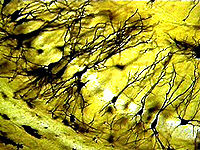
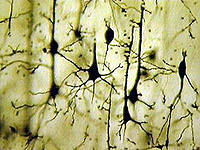
Fig. 1: hippocampus Neuron . (Credit: "Slice of life" Project)
A typical neuron receives signals from a number of neurons that can be
from several hundred to a few tens of thousands.
The axon of a neuron sends a signal to dendride of another neuron connections
through synapses said.

Fig. 2:Pulse in neuro electric transmission.
(Credit: Eric H. Chudler - "Neuroscience for kids")
These connections lead to the formation of complex neural circuits through which information travels. Nervus Information consists primarily by electrical signals (the fastest of which is the action potential; Fig 2) which are not normally able to spread from one neuron to another because at the level of synapses there is no continuity physical between nerve cells connected.
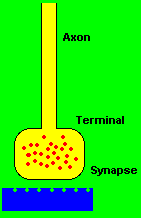
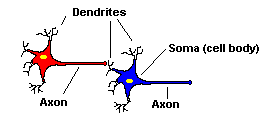
Fig. 4: Step towards the membrane presinaptica
of vesicles (red dots) containing neurotransmitters. |
Fig. 3: Example for
Neuron connection (Credit: Eric H. Chudler - "Neuroscience for kids") |
At the level of synapses the electrical signal (which travels nell'assone) becomes the issue of a signal chemical (neurotransmitter) that determines the neuron following the onset of a new electrical signal (Fig. 4)
Synapses Plastic
The synaptic connection is the nodal point for the flow of signals and information into brain circuits.
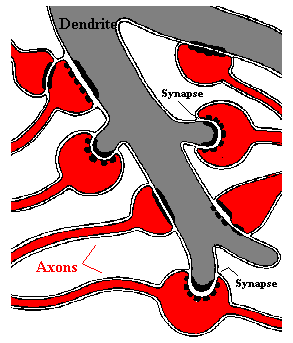 |
 |
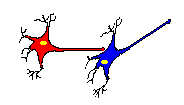 |
Fig.1: Connection
Between axon and dendrid. (Credit: Eric H. Chudler - "Neuroscience for kids") |
Fig. 2: type of synapsesi. (Credit: Eric H. Chudler - "Neuroscience for kids") |
No wonder then that today the neural basis of complex brain activities such as learning and memory and intellectual abilities are individual sought mainly in their operation. In particular, these complex functions are associated with ownership of synaptic connections to become stronger or weaker according to previous activities, or even be eliminated or formed from scratch. This property is identified with the term synaptic plasticity and the ability of the brain continually recast the operation of its nerve circuits on the basis of previous experience and therefore, was theorized in complete form for the first time by Donald Hebb in 1949 (hence the term of Hebbian synapses to indicate a synapse that amends its functionality based on previous year).